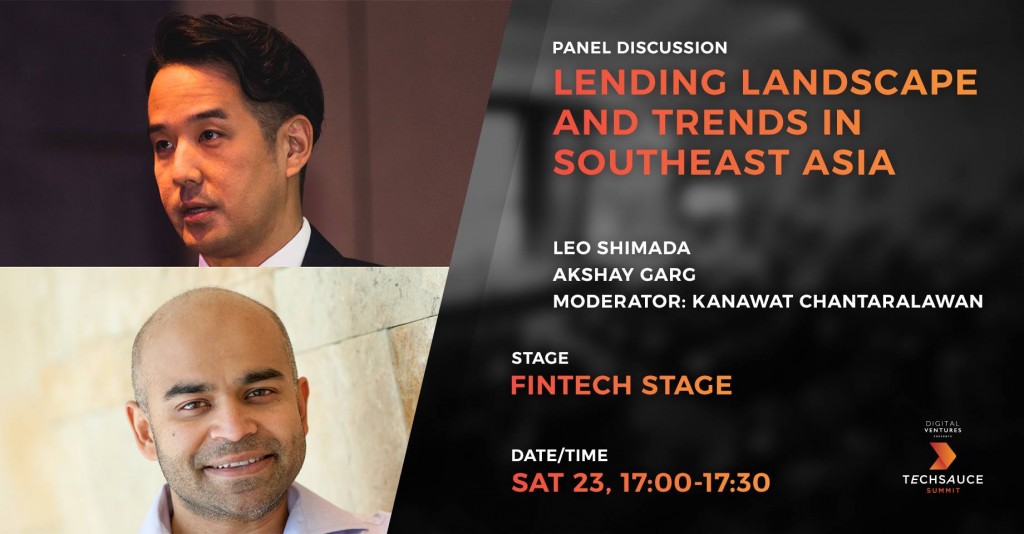Lending landcape and trends in South East Asia
New alternative funding models such as peer to peer lending and equity crowdfunding gained significant traction in the United States, United Kingdom and China over the past couple of years. However, the sector is not without its problems – few months ago, we saw the stepping down of Lending Club’s CEO and China’s Ezubao revealed as a Ponzi scheme. In this session, we explore the alternative funding scene in ASEAN, challenges facing this industry and the regulatory environment.
Panel Discussion with:
- Leo Shimada - Co-Founder and CEO of Crowdo
- Akshay Garg - CEO of Finaccel
- Moderated by Kanawat Chantaralawan - CEO of Ruckdee
Introduction
Leo: Crowdo is regional FinTech startup offering full portfolio of crowdfunding solutions including peer to business lending and equity crowdfunding. Crowdo is licensed by the Securities Commission in Malaysia and the Monetary Authority of Singapore.
Akshay: Finaccel is an alternate data based lending company. Finaccel perform analyses by crawling the internet to create credit risk profiles and use them to extend loans (specifically for e-commerce financing).
How do you differentiate your company from the traditional lenders?
Leo:
- Taking a data driven approach to using alternative data points to improve the issuance of loans and repayment history
- Processed 600 loans in Indonesia, many turned down by banks, actually creditworthy using Crowdo’s scoring methodologies.
- Look at psychometric testing, social media data, geolocation data and other tried and tested traditional means.
- To make the whole experience as fast and cheap as possible.
- Cost structure is lean and cheap, also managed to convinced partners to understand unit economics and focus on the long term.
Akshay:
- Traditional method – apply a credit card, or credit from someone like AEON finance, which works well offline but not online. Currently, there is no way to pay in instalments for products online from sites like Lazada.
- Plug into merchants on the product page itself. If someone wants to pay in instalments, they click a button for Kredivo and goes through a one-minute process where they crawl through thousands of data points and come up with a credit score. Borrowers will know right then and there whether they’re approved or not.
- The borrower then need to provide some documents like national ID or proof of address. If it’s a low ticket item, doesn’t even require proof of income as they run an income model in the background.
- The entire process is digitised and automated, and it’s also in real time.
How you differentiate from Paypal and Stripe?
Akshay: They are cashed based wallets, and we’re giving people a credit limit, like a new generation virtual credit card that’s a 2-click checkout, without the need to key in credit card details.
What are the challenges that you’ve faced?
Akshay:
- Navigating regulations – as a FinTech startup, regulations are part and parcel of our life and spend significant amount of time figuring out regulations around e-signature, digital documents and lending license requirement.
- It’s a sophisticated idea – spend time educating merchants. Merchants need what they offer as credit financing increases sales a lot. It takes a bit of time for merchants to understand how it works.
- Finding new people, talent is a huge constraint and we can’t hire quick enough.
Leo:
- License acquisition:
- Crowdo don’t have the resources of the big banks, but have acquired two licenses in Singapore and Malaysia by spending time to understand the law by themselves.
- The need to offer full stack – not just product development and marketing but all the way up to the policy level:
- 20% of time engaging regulators and policy makers.
- As a representative of the FinTech space, to help shape the future.
- Maturity of the FinTech ecosystem:
- Would love to plug into other services provider such as remittance, e-payment and RegTech companies.
- May be able to do that in UK and Silicon Valley, but many parts of the ecosystem and value chain is not complete in Southeast Asia.
- For example, the trustee company’s cost structure is geared towards multi-million dollar deals, so unit economics don’t make sense. A lot of time is spent on negotiations such as this.
Customers that go to your platforms are considered riskier?
Leo:
- A SMB Bank turned down $1b worth of loan applications, only about 20% of those are forecasted to be impacted loans. The financial institutions are getting more risk averse now and avoid getting into businesses like peer to peer lending, which sounds like sub-prime.
- Borrowers that go to Crowdo, there’s a lot of overlap with clients that would’ve gotten loans from banks but are being turned down by banks for some reason. Even clients that the bank have been working with for years are being turned down for business expansion into other countries.
- Crowdo is seeing good quality borrowers that are going to Crowdo because of inefficient decision making in the banks or traditional decision making frameworks.
Akshay:
- Echoing what Leo has mentioned, the same thing is happening in the consumer finance space.
- For example: Indonesia - 260 m people, 80m middle class, 8m credit card holders, hasn’t increased in the past 8 years, in fact lower than 2007. Does that mean that 72m middle people in the middle class is not creditworthy?
- Credit bureau don’t have enough high quality data, and the government has been trying to set up private credit bureaus.
- The consumer finance application process is a disaster and nothing has changed in the past 30 years.
- We’re not lending to sub-prime customers. These are prime customers, who for some reason, are rejected by the banking and traditional financing ecosystem.
What is your response to the increasing trends in crowdfunding?
Leo:
- It’s amazing because startups and SMEs are able to access alternative means of financing. SMEs are often the backbone of the economy.
- It’s good for the investors as interest rates are lower than 2-3% and inflation rates are 7-8%. Creates additional yield and a fairer wealth creating opportunity.
- Diversification of products from rewards crowdfunding and into more main stream peer to peer lending and equity crowdfunding for businesses.
How do you determine if the company should issue debt or equity?
Leo:
- We manage that by giving choice – when client comes to Crowdo with negative cashflow, it will be within equity crowdfunding, and if there’s negative cashflow but have assets that can be collateralised, it would fall under peer to business lending.
-
Each product has different due diligence criteria. For peer to business lending – people care more about their ability to repay. For equity crowdfunding – in addition to financials, they will have to build additional case around passion, etc.
Project owners are concerned about intellectual property and their ideas getting stolen. How do you manage this?
Leo: I would tell them that you’re asking people to put in money so more disclosure definitely helps. Because Crowdo is licensed platform, there is some trust that Crowdo is doing the proper due diligence on intellectual property assets.
Akshay added that:
- Finaccel is a way for lenders to open up new revenue sources. Lenders had been focusing on people who have a credit file and these are people who are overtapped already.
- Opening up the thin file customers, thin file doesn’t necessarily mean bad, but they’re emerging borrowers who don’t have enough data in the ecosystem.
- For lenders, to increase their loan book and develop high quality portfolio. For borrowers, to access credit in very fast, simple, reliable way and quite enjoyable experience.
As a marketplace, which side do you grow first?
Akshay:
- Decided to work with lenders, as their business model is not to lend directly.
- Focus on consumers (borrowers) and merchants. As they’re starting out, they focused on increasing the supply side, which is the merchant side. If they achieve critical mass, then they would start focusing on the consumer side.
Which factors do you take into account for credit scoring?
Akshay:
- Probabilistic and runs 4 models – credit scoring model, income prediction model, identity verification model and address verification model in real time.
- A lot of different data points that go into each model. For credit scoring model, it’s about 3,500 variables and expected to grow to around 10,000 variables by year end.
- 4 macro buckets – self reported data, mobile phone data, social and professional profile and environmental data.
- Data points that are very predictive – no. of contact in phonebook, no of Facebook friends, education level and marital status.
What are your suggestions for regulations in Thailand for lending based platforms?
Akshay:
- Any data that we ask from user, we’re not getting any data without their consent - we get permission from the user. We are not looking at anything personal, these are basic Andriod permissions and none of these data are private data.
- We’re focused on the user experience for merchant and borrowers, and secondly we focus on credit scoring. We’re a tech company and we don’t have to worry about regulations because we’re not disbursing the loan but the lender (our partner) is.
Leo:
- Risk of not being regulating is much greater than regulating and jumpstarting the industry. If don’t regulate, will definitely see offshore, grey operators that circumvent regulations
- Equity is by nature is low traction, and will actually scare regulators because the volume is low.
- That’s the reason why in Singapore, both equity and debt are bundled under securities crowdfunding.
- This is a little bit controversial as it’s against capitalism – if regulators open up the industry, they should determine the number of licenses to issue. Easier for regulators to obtain updates and reports, there’s a group to go to, makes it easier for platform operators because they can determine the competitive landscape and differentiate themselves.
- There’s a struggle in determining whether it’s a lending product or securities product and which agency it’s linked to. From the platform’s operative point of view, this can be structured as an investment product or a debt instrument, so it’s no longer a technical issue and it’s up to the agency to decide.
ลงทะเบียนเข้าสู่ระบบ เพื่ออ่านบทความฟรีไม่จำกัด







